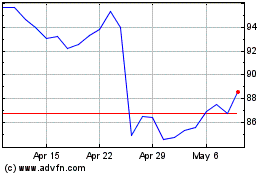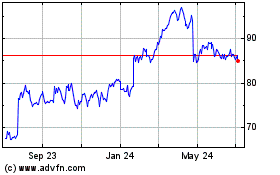GE Pushes Into Turboprop Engines, Taking on Pratt
November 16 2015 - 2:33PM
Dow Jones News
By Ted Mann
General Electric Co. said it is developing a new family of
turboprop engines, taking aim at a market stronghold of rival Pratt
& Whitney.
GE said Monday it had signed on with Textron Inc., maker of
Cessna, Hawker and Beechcraft planes, to provide the power plant
for a new single-engine plane it will launch toward the end of the
decade. Textron accounts for more than half of all general aviation
aircraft in use today, the company says.
The announcement is GE's boldest move to crack into a market
that has been dominated for decades by Pratt & Whitney, a
division of United Technologies Corp. Pratt has sold more than
50,000 engines for small planes like Cessnas used by general
aviation pilots.
On Monday, Pratt also announced a new variant of its PT6 engine
that it said would boost power and efficiency from previous models.
The PT6 is the dominant engine on general aviation aircraft,
according to data from the General Aviation Manufacturers
Association, a trade group. And Textron has been a major customer
for Pratt's PT6 engines, which it uses on brands like Cessna and
Beechcraft. Those two brands shipped 221 airplanes equipped with
Pratt engines last year, according to GAMA's data, down from 240
the previous year.
In a news release, Textron said it expected the new plane to
outperform competitors in cost and performance.
Nicholas Kanellias, general manager of general aviation programs
for Pratt & Whitney Canada, which makes the PT6, said the
company was continuing to improve and upgrade the engines, and
would do so despite the new challenge from GE.
"We have spent over 50 years focusing on innovation and working
closely" with customers, Mr. Kanellias said. "We have done this in
a competitive landscape throughout these 50 plus years."
GE is using some of the technology and strategy developed in its
much larger commercial jet engine business as it prepares to more
aggressively take on the turboprop market, said Brad Mottier,
general manager of business and general aviation in GE's engine
business.
The company will develop and test the new engine at a $400
million new turboprop center it is building in Europe. GE already
builds turboprops at a factory in the Czech Republic and says the
expanded center will support up to 1,000 jobs. The company says it
will launch the first full test of the new engine in 2018.
While general aviation engines spend far less time in the air
than those on commercial airliners, they also require much more
frequent overhaul and maintenance, Mr. Mottier said, offering the
promise of a steady stream of service revenue.
The new GE engine will feature computerized management of the
engine and propulsion controls that will allow 20% greater fuel
efficiency and 10% greater power than comparable models, Mr.
Mottier said.
Winning the deal with Textron to provide engines for its new
aircraft was crucial to GE's efforts, Mr. Mottier said. Unlike the
commercial engine market, where there are only a few major
airframers, the market for small aircraft is much more fragmented
and diverse. "If you win Textron, you can justify a new program
investment," he said.
Write to Ted Mann at ted.mann@wsj.com
Subscribe to WSJ: http://online.wsj.com?mod=djnwires
(END) Dow Jones Newswires
November 16, 2015 14:18 ET (19:18 GMT)
Copyright (c) 2015 Dow Jones & Company, Inc.
Textron (NYSE:TXT)
Historical Stock Chart
From Mar 2024 to Apr 2024

Textron (NYSE:TXT)
Historical Stock Chart
From Apr 2023 to Apr 2024
